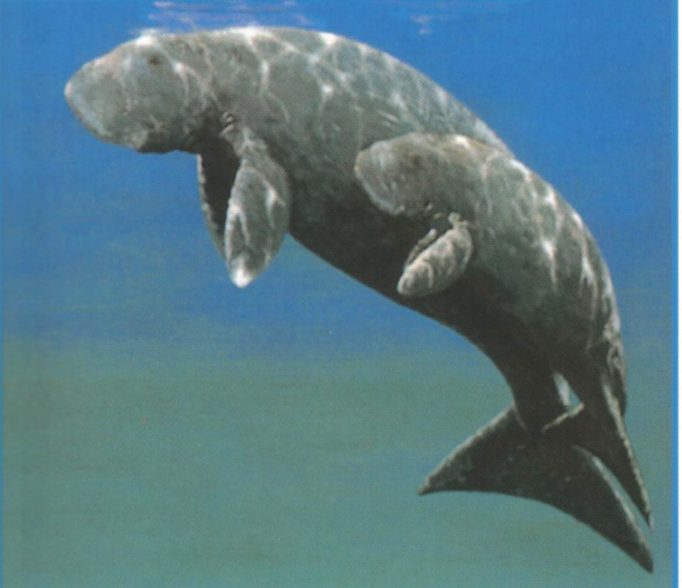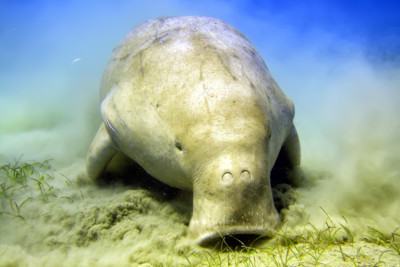The Dugong (Dugongidae) is the only strictly herbivorous marine mammal. It is one of four living species of the order Sirenia, which also includes three species of manatees. The Dugong is the only living mammal of the once-diverse family Dugongidae. Its closest relative, the Steller’s sea cow (Hydrodamalis gigas), was hunted to extinction in the 18th century. Dugongs and other Sirenians are not closely related to other marine mammals, and are rather more related to elephants. The Dugong, elephant, hyrax, and aardvark share a monophyletic group, meaning, they are descendants of the same ancestral group. Common names of the Dugong include sea cow, sea pig and sea camel.
Food and Habitat. The Dugong is the only Sirenian found in the warm coastal waters of less than 40 countries from the western Pacific coasts to the eastern African coasts. Their historic range, which is along 86,992 miles of coastline between 26° and 27° degrees to the north and south of the equator, corresponds to the seagrasses from the Potamogetonaceae and Hydrocharitaceae families.
The Dugong feeds mainly on seagrass for subsistence and its habitats are thus restricted to coasts that protect its seagrass meadows. When a Dugong feeds, whole plants are uprooted, thus, aerating the sea floor; increasing the organic matter in the area; and encouraging regrowth of the seagrass. Dugongs are thus known as cultivation grazers, because they inadvertently cultivate the seagrass, particularly Halophila ovalis, their preferred species.
Description. As a Sirenian, the body of a Dugong is rotund, like a spindle with tapered ends. It has neither a dorsal fin nor hind limbs. The fore limbs or flippers look like paddles. The Dugong has a fluked, dolphin-like tail, while a manatee has a paddle tail. The Dugong also possesses a unique head. It has very small eyes, thus, has limited vision but has acute hearing within narrow sound limits. Their ears are located on the sides of the head, while their nostrils are located on top of the head and can be closed using valves. Their snout is sharply down-turned, with a large horseshoe-shaped upper lip forming a highly mobile muzzle. The Department of Environment and Heritage Protection of Australia finds that due to poor eyesight, the Dugong relies on the sensitive bristles covering the upper lip to find and grasp seagrass. Communication between Dugongs is through chirps, whistles, and barks that echo underwater. Different sounds have different amplitudes and frequencies that imply different purposes.
The male Dugong has two incisors like tusks that emerge during puberty. The female’s tusks do not emerge during puberty, but later in life. The number of growth layer groups in a tusk can indicate the age of a Dugong, and their cheekteeth move forward with age. Like other Sirenians, the Dugong experiences Pachyostosis, a condition in which their ribs and other long bones are unusually solid and contain little or no amount of bone marrow. Their dense and heavy bones act as a ballast to keep Sirenians suspended below the surface of the water.
Dugongs may live for 70 years or more, and are slow breeders. The shallow waters are used as sites for calving. The deep waters are used to provide a thermal refuge from cooler waters closer to shore during winter. Female Dugongs breed between 8-18 years old (Anderson, P. and Macdonald, D., The Encyclopedia of Mammals). Dugongs calve only once every 2.5-7 years, and environmental conditions play a big role (IUCN, 2015).
A typical adult Dugong has a length of about 9.8 ft., and weighs between 926 lbs. to 1,984 lbs. The largest Dugong recorded was 13.32 ft long, and weighed 2,240 lbs. It was found off the coast of Saurashtra in western India. Females tend to be larger than males.
Groupings. The largest Dugong concentrations typically occur in wide, shallow, protected areas such as bays, mangrove channels, waters of large inshore islands, and inter-reefal waters with seagrass meadows.
Results of molecular studies done on Dugong populations using mitochondrial DNA suggest the Dugong population of Southeast Asia is distinct from the others. Australia has two distinct maternal lineages, which includes Dugongs from Africa and Arabia. Limited genetic mixing has taken place between those in Southeast Asia and Australia, mostly rather around Timor. But data is insufficient to draw boundaries between distinct groups.
IUCN Red List Category. The Dugong has been hunted for thousands of years for its meat, oil, skin, tusks and bones. Traditional hunting still has great cultural meaning in several countries in the Dugong’s range, particularly northern Australia and the Pacific Islands. The Dugong’s current distribution is fragmented, and many populations are close to extinction. The IUCN listed in July 2015 that the Dugong as Vulnerable to extinction. With a slow rate of reproduction, the Dugong is especially Vulnerable. The Convention on International Trade in Endangered Species bans the trade of derived products.
Population Decline. The Dugong is protected throughout Australia and Papua New Guinea, except from indigenous hunting. Torres Straits supports a large Dugong population, and promotes sustainable hunting by the indigenous peoples of Torres Straits and the adjacent Papua New Guinea. The Dugong populations of southern Queensland (Hervey Bay and Moreton Bay) are stable. The northern waters of Australia between Shark Bay and Moreton Bay are believed to have the highest number of Dugongs. The second largest is in the Persian Gulf. The third largest is in New Caledonia.
Despite this, the Dugong population is thought to be shrinking with a worldwide decline of 20% in the last 90 years according to the last major worldwide IUCN study in 2002 by H. Marsh and S. Sobtzick. The report not only concluded that the Dugong population was declining, but possibly already Extinct in a third of its range.
In the Mediterranean, where the Dugongidae originated in the mid-late Eocene age, the Dugong has become Extinct.
In East Africa, where herds of 500 were observed in the 1960s, now only 50 or less can be spotted in Madagascar, Mozambique, Mauritius, Seychelles, and Aldabra Atoll.
In South Asia, particularly in the waters of Borneo, the Straits of Johor, and the Andaman and Nicobar Islands in the Bay of Bengal, a small number of Dugongs are present. In Sri Lanka, where Dugongs used to surround its coastline, now only the northeastern coast has Dugongs. In Pakistan, the Dugong is considered Endangered. In the Maldives and Laccadive Islands, however, where their habitats once centered, Dugongs have become Extinct.

Dugong cow and calf in Philippine coastal waters. Photo Credit: Neptune911.com
In East Asia, the Dugong population has either diminished rapidly down to dangerous levels, or virtually disappeared in Hong Kong, Taiwan, Hainan, Cambodia, Vietnam, Thailand, Japan, and the Philippines, considering that the Dugong was the first marine mammal to be protected by the country. In 2003, 20 scientists considered the Dugongs in the Philippines as Critically Endangered, as reported by Neptune911.com.
According to IUCN, all the islands of the Philippines were believed to have once provided habitats for Dugongs, which were common until the 1970s. The name Dugong was derived from the Tagalog word of northern Philippines, which means “lady of the sea.” Muller classified it as Trichechus Dugon in 1776, and indicated that the Type Locality was from the Cape of Good Hope (South Africa) to the Philippines. Dugongs are often considered as inspiration for seafarer tales of mermaids and sirens (National Geographic, 2011). In the Philippines, the mermaid is called “Sirena,” which sounds like the Dugong order “Sirenia.” In Malaysia, there is a 5,000-year-old wall painting of a Dugong drawn during the neolithic era in the Tambun Cave of Ipoh that was discovered by Lt. R.L. Rawlings in 1959 while on a routine patrol. In Malaysia, the Dugong is called Duyung.
Threats and Environmental degradation. Dugongs are vulnerable to vessel strikes as they surface to breathe, putting themselves directly in the path of boats. Dugongs are also vulnerable to bycatch in commercial fishing nets. If Dugongs do not get enough seagrass to eat they may breed later, and produce fewer calves. Shortage of seagrass are caused by loss of habitat and a disturbance of feeding caused by waste products such as sewage, detergents, heavy metal, hypersaline water, and agricultural herbicides. Human activities such as mining, trawling, dredging, land-reclamation, and pollution play a major role in damaging seagrass meadows. Boat propellers cause an increase in sedimentation that can smother the surrounding seagrass, and consequently prevent light from reaching the seagrass under water. Extreme weather such as cyclones and severe floods destroy vast seagrass meadows, and wash the Dugongs to shore. The damaged seagrass meadows take over a decade to recover, resulting in food shortage for the Dugongs. Consequently, most measures for the protection of Dugongs restrict trawling in seagrass meadows, but with little or no action against chemical pollutants originating from land. Moreover, in some countries, protection laws may have been passed, but unfortunately, are unenforced.
